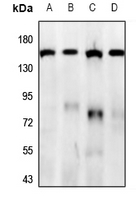Anti-GPR158 Antibody
Rabbit polyclonal antibody to GPR158
- SPECIFICATION
- CITATIONS
- PROTOCOLS
- BACKGROUND

Application
| WB |
|---|---|
| Primary Accession | Q5T848 |
| Reactivity | Human, Mouse, Rat |
| Host | Rabbit |
| Clonality | Polyclonal |
| Calculated MW | 135489 Da |
| Gene ID | 57512 |
|---|---|
| Other Names | KIAA1136; Probable G-protein coupled receptor 158 |
| Target/Specificity | Recognizes endogenous levels of GPR158 protein. |
| Dilution | WB~~WB (1/500 - 1/1000) |
| Format | Liquid in 0.42% Potassium phosphate, 0.87% Sodium chloride, pH 7.3, 30% glycerol, and 0.09% (W/V) sodium azide. |
| Storage | Store at -20 °C.Stable for 12 months from date of receipt |
| Name | GPR158 {ECO:0000303|Ref.1, ECO:0000312|HGNC:HGNC:23689} |
|---|---|
| Function | Metabotropic receptor for glycine that controls synapse formation and function in the brain (PubMed:36996198). Acts as an atypical G-protein coupled receptor that recruits and regulates the RGS7-GNB5 complex instead of activating G proteins (PubMed:31189666, PubMed:36996198). In absence of glycine ligand, promotes the GTPase activator activity of RGS7, increasing the GTPase activity of G protein alpha subunits, thereby driving them into their inactive GDP-bound form (PubMed:36996198). Glycine-binding changes the conformation of the intracellular surface, inhibiting the GTPase activator activity of the RGS7-GNB5 complex, promoting G protein alpha subunits into their active GTP-bound form and regulating cAMP levels (PubMed:36996198). Also able to bind taurine, a compound closely related to glycine, but with a two- fold lower affinity (PubMed:36996198). Glycine receptor-dependent regulation of cAMP controls key ion channels, kinases and neurotrophic factors involved in neuronal excitability and synaptic transmission (PubMed:36996198). Plays a pivotal role in regulating mood and cognition via its ability to regulate neuronal excitability in L2/L3 pyramidal neurons of the prefrontal cortex (By similarity). Also involved in spatial learning by regulating hippocampal CA1 neuronal excitability (By similarity). Acts as a synaptic organizer in the hippocampus, required for proper mossy fiber-CA3 neurocircuitry establishment, structure and function: induces presynaptic differentiation in contacting axons via its interaction with GPC4 (By similarity). In addition to glycine, may also act as a receptor for osteocalcin (BGLAP) hormone: osteocalcin-binding initiates a signaling response that prevents neuronal apoptosis in the hippocampus and regulates the synthesis of neurotransmitters (By similarity). |
| Cellular Location | Cell membrane; Multi-pass membrane protein. Postsynaptic cell membrane {ECO:0000250|UniProtKB:Q8C419}; Multi-pass membrane protein. Presynaptic cell membrane {ECO:0000250|UniProtKB:Q8C419}; Multi-pass membrane protein Nucleus Note=Mainly localizes to the postsynaptic membrane, with a small portion to the presynaptic membrane (By similarity). Trafficks between the nucleus and the cell membrane; it is unclear how a multi-pass membrane protein can traffick between the nucleus and the cell membrane (PubMed:23451275). {ECO:0000250|UniProtKB:Q8C419, ECO:0000269|PubMed:23451275} |

Thousands of laboratories across the world have published research that depended on the performance of antibodies from Abcepta to advance their research. Check out links to articles that cite our products in major peer-reviewed journals, organized by research category.
info@abcepta.com, and receive a free "I Love Antibodies" mug.
Provided below are standard protocols that you may find useful for product applications.
Background
KLH-conjugated synthetic peptide encompassing a sequence within the N-term region of human GPR158. The exact sequence is proprietary.
If you have used an Abcepta product and would like to share how it has performed, please click on the "Submit Review" button and provide the requested information. Our staff will examine and post your review and contact you if needed.
If you have any additional inquiries please email technical services at tech@abcepta.com.













 Foundational characteristics of cancer include proliferation, angiogenesis, migration, evasion of apoptosis, and cellular immortality. Find key markers for these cellular processes and antibodies to detect them.
Foundational characteristics of cancer include proliferation, angiogenesis, migration, evasion of apoptosis, and cellular immortality. Find key markers for these cellular processes and antibodies to detect them. The SUMOplot™ Analysis Program predicts and scores sumoylation sites in your protein. SUMOylation is a post-translational modification involved in various cellular processes, such as nuclear-cytosolic transport, transcriptional regulation, apoptosis, protein stability, response to stress, and progression through the cell cycle.
The SUMOplot™ Analysis Program predicts and scores sumoylation sites in your protein. SUMOylation is a post-translational modification involved in various cellular processes, such as nuclear-cytosolic transport, transcriptional regulation, apoptosis, protein stability, response to stress, and progression through the cell cycle. The Autophagy Receptor Motif Plotter predicts and scores autophagy receptor binding sites in your protein. Identifying proteins connected to this pathway is critical to understanding the role of autophagy in physiological as well as pathological processes such as development, differentiation, neurodegenerative diseases, stress, infection, and cancer.
The Autophagy Receptor Motif Plotter predicts and scores autophagy receptor binding sites in your protein. Identifying proteins connected to this pathway is critical to understanding the role of autophagy in physiological as well as pathological processes such as development, differentiation, neurodegenerative diseases, stress, infection, and cancer.


